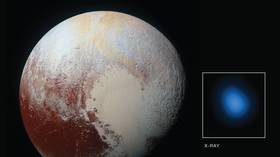Pluto’s beating ‘frozen heart’ is in charge of its weather – study

New research shows that not only does Pluto’s unique “frozen heart” actually control the dwarf planet’s weather systems, it does so with a “beat.”
When NASA’s New Horizons mission captured footage of the dwarf planet in 2015, scientists found that, contrary to popular opinion at the time, Pluto did in fact have some physical features on its landscape and was not just a barren, flat and frozen wasteland.
Instead, the dwarf planet boasted a vast heart-shaped structure, named Tombaugh Regio (after the astronomer who discovered Pluto), which new research shows actually controls Pluto’s atmospheric circulation through daily warming and cooling cycles.
Pluto’s atmosphere is comprised mostly of nitrogen gas along with carbon monoxide and methane and is 100,000 times thinner than the Earth’s. During the day, the planet’s “heart” warms and turns into vapor, only for that vapor to condense again at night, producing a kind of atmospheric “heartbeat” which sends nitrogen winds across the surface.
Also on rt.com ‘Pluto is a planet’: NASA official risks sparking science civil war with controversial declarationThese winds blow in the opposite direction to its spin in a phenomenon known as retro-rotation and help to form nitrogen-rich glaciers which add further relief to the dwarf planet’s landscape.
“Before New Horizons, everyone thought Pluto was going to be a netball—completely flat, almost no diversity,” Tanguy Bertrand, NASA astrophysicist and planetary scientist and the study’s leading author, said.
“But it’s completely different. It has a lot of different landscapes and we are trying to understand what’s going on there.”
Think your friends would be interested? Share this story!














